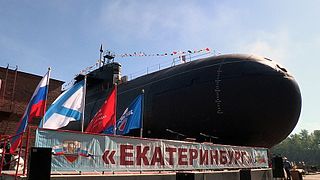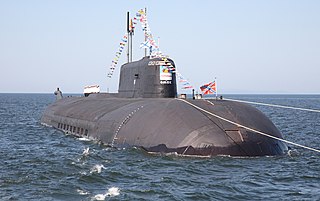Development and design
The design assignment was issued in 1969. The development of Project 949 was a new stage in the development of APRC-class submarines, which, in accordance with the concept of asymmetric response, were tasked with countering aircraft carrier strike formations. The new missile submarines were to replace the submarines of Projects 659 and 675 and in accordance with the terms of reference surpassed them in all basic parameters - could launch missiles from both surface and underwater position, had less noise, higher underwater speed, three times higher ammunition, missiles with radically improved combat capabilities. Project 949 became the pinnacle and the end of the development of highly specialized submarines (aircraft carrier killers). In December 2011, they became known that the Rubin Central Design Bureau had developed a modernization project. It is planned to replace the P-700 missiles with the more modern P-800 Oniks missiles from the Caliber family. Modification of launch containers is planned, without alteration of the hull. The modernization of the nuclear submarine of the Northern Fleet will be carried out at the Zvezdochka CS, and the Zvezda shipyard. [3]
The design is double-hulled, with a distance between a light and durable body of 3.5 meters, which provides a significant buoyancy margin, up to 30%, and provides additional protection against underwater explosions. For their characteristic appearance, they received the nickname baton, [4] and for their powerful strike weapons they were nicknamed aircraft carrier killers. The robust housing is divided into ten internal compartments. [5]
Construction and career
The submarine was laid down on 8 May 1985 at Sevmash, Severodvinsk. Launched on 27 December 1987 and commissioned on 30 December 1988. [6] On 13 April 1993, she was renamed Irkutsk.
On 21 July 1990, K-132 near Bear Island dived to a depth of 460 metres (1,510 ft) meters. From 30 August to 27 September of the same year, she made an ice crossing through the Arctic from Zaozersk to Vilyuchinsk. On 29 October she entered the Pacific Fleet.
In 1992, for the first time in the Pacific Fleet, she fired two P-700 Granit missiles.
On 23 May 1996, Irkutsk and K-456 fired group cruise missiles at one target. In 1997, Irkutsk was put on stand-by, awaiting mid-life repairs.
In November 2001, Irkutsk was brought to Bolshoi Kamen at the Zvezda shipyard. [7]
In 2008, repairs began, and at first it was planned to carry out medium repairs, then the customer corrected the terms of reference for the restoration of technical readiness with a corresponding decrease in funding. According to the director of the Zvezda shipyard, Andrei Rassomakhin, in an interview dated 29 August 2008: about 6 billion rubles are required for repairs, while the cost of a new ship is 40-50 billion, and the funding provided for in the state contract should be considered insufficient. [8]
On 7 December 2013, the Zvezda Far East Plant announced the start of modernization of K-132 Irkutsk. The modernization project was prepared by the Rubin St. Petersburg Marine Engineering Design Bureau. In November 2013, the Zvezda plant commission approved the project by signing an agreement with Rubin. According to the documentation, 12 billion rubles were expected to be spent on all work. A total of 27 Rubin's contractors took part in the project. Among them: JSC Concern Morinformsistema-Agat, JSC Concern NPO Avrora, FSUE Central Research Institute of Structural Materials Prometey and JSC Central Design Bureau Lazurit. Under the modernization program, strike weapons, navigation equipment and other systems will be updated, as well as the hull of the boat will be strengthened. [9]
K-132 Irkutsk, which was being modernized at the Far Eastern Zvezda plant, returned to the Pacific Fleet in 2019, Interfax-AVN reported, citing a source in the shipbuilding industry. Irkutsk was being modernized at the Zvezda shipyard according to the Project 949AM. The ship was able to return to service two years later than planned. [9] In reality, the start of the repair of Irkutsk was announced in the press service of the enterprise only on 30 July 2019. In a planned manner, work was underway to troubleshoot and repair ship fittings, general ship devices, steering drives. The deadline for the delivery of the nuclear submarine is set for 2022. [10]
During his working trip, Deputy Defense Minister Alexei Krivoruchko visited the enterprises of the military–industrial complex of the Far East. The main goal is to verify the fulfillment by enterprises of the state defense order of 2019. Summing up the visit to the Far Eastern shipbuilding cluster, Krivoruchko told reporters that Irkutsk, which was being upgraded at the Zvezda shipyard to the Project 949AM level, would be equipped with a universal launch complex that will allow the use of Zircon hypersonic missiles. The service life of the vessel will, reportedly, be extended by ten years. [11] The submarine is scheduled to be handed over to the Pacific Fleet in 2023. [12] [13] [14]
On 23 June 2022, it was reported the submarine started post-refit sea trials. Modernised Irkutsk will carry 48 missiles. [15]
Pennant numbers
| Date | Pennant number [16] |
|---|
| 1990 | 601 |
| 2000 | 929 |

The Oscar class, Soviet designations Project 949 Granit and Project 949A Antey, are a series of nuclear-powered cruise missile submarines designed in the Soviet Union for the Soviet Navy. First built in the 1970s, six remain in service with the Russian Navy. Two other vessels were slated to be modernized since at least 2017 as Project 949AM, to extend their service life and increase combat capabilities but it is unclear whether work continues as of 2023.

The Kirov class, Soviet designation Project 1144 Orlan, is a class of nuclear-powered guided-missile battlecruisers of the Soviet Navy and Russian Navy, the largest and heaviest surface combatant warships in operation in the world. Among modern warships, they are second in size only to large aircraft carriers, and of similar size to a World War I-era battleship. The ships are often referred to as battlecruisers by Western defence commentators due to their size and general appearance. The Soviet classification of the ship-type is "heavy nuclear-powered guided-missile cruiser".

The Delta class, Soviet designations Project 667B Murena, Project 667BD Murena-M, Project 667BDR Kalmar, Project 667BDRM Delfin, are a family of nuclear-powered ballistic missile submarines, designed and built in the Soviet Union, which formed the backbone of the Soviet and Russian strategic submarine fleet since their introduction in 1973. They carry nuclear ballistic missiles of the R-29 Vysota family, with the Delta I, Delta II, Delta III and Delta IV classes carrying the R-29/SS-N-8 'Sawfly', R-29D/SS-N-8 'Sawfly', R-29R/SS-N-18 'Stingray' and R-29RM/SS-N-23 'Skiff' respectively.

The Borei class, alternate transliteration Borey, Russian designation Project 955 Borei and Project 955A Borei-A, are a series of nuclear-powered ballistic missile submarines being constructed by Sevmash for the Russian Navy. The class is projected to replace the Soviet-era Delta III, Delta IV and Typhoon classes in Russian Navy service.

The Yasen class, Russian designations Project 885 Yasen and Project 885M Yasen-M, also referred to as the Graney class, are a series of nuclear-powered cruise missile submarines designed by the Malakhit Marine Engineering Bureau and built by Sevmash for the Russian Navy. Design work commenced in earnest in the 1980s with the first submarine built in the 1990s–early 2010s with commissioning in 2013. Two additional boats to a modified Yasen-M design were commissioned in 2021 and six more are under construction. Based on the Akula class and Alfa class designs, the Yasen class is projected to replace the Russian Navy's current Soviet-era nuclear attack submarines. The Akula class is optimised for a hunter-killer role, whereas the Yasen class concept uses the platform as a nuclear guided missile submarine (SSGN).

Admiral Nakhimov is the third battlecruiser of the Russian Navy's Kirov class. The ship was originally commissioned into service with the Soviet Navy in 1988, known back then as Kalinin (Калинин), a name the ship kept until 1992 when it was renamed for Pavel Nakhimov. From 1997 Admiral Nakhimov is undergoing a repair and a refit to receive new and improved weaponry and had been scheduled to re-enter service with the Russian Navy in around 2022. The date for the ship's return to service is uncertain. In 2021 it was reported that the ship's return to service would be delayed until "at least" 2023 while in February 2022 it was reported that Sevmash CEO Mikhail Budnichenko noted that the warship was planned for delivery in 2022. Later in the year it was again reported that the vessel's return to service might be delayed as late as 2024, with this being eventually confirmed by the head of United Shipbuilding Corporation Alexei Rakhmanov.

JSC PO Sevmash is a Russian joint-stock company (JSC) under the vertically-integrated United Shipbuilding Corporation. The shipbuilding operations of Sevmash is in the port city of Severodvinsk on the White Sea in the Russian Federation.

K-549 Knyaz Vladimir is a Borei-class nuclear-powered ballistic missile submarine, and the first upgraded Borei-A unit to enter service with the Russian Navy. The submarine is named after Knyaz Vladimir the Great.

K-84 Ekaterinburg is a Project 667BDRM Delfin-class nuclear-powered ballistic missile submarine. The submarine was laid down on 17 February 1982 at the Russian Northern Machine-Building Enterprise (Sevmash). It was commissioned into the Soviet Navy on 30 December 1985. After the collapse of the Soviet Union, the submarine continued to serve in the Russian Navy. Initially known only by its hull number, in February 1999 it was renamed after the city of Yekaterinburg.

K-266 Orel is a Project 949AM nuclear-powered cruise missile submarine (SSGN). She is one of three Oscar II submarines still serving in the Russian Northern Fleet, all assigned to the 11th Submarine Division, berthed at Guba Bolshaya Lopatka, on the Kola Peninsula northwest of Severomorsk.

Knyaz Oleg is a Borei-class nuclear-powered ballistic missile submarine developed by the Rubin Design Bureau and constructed by the Sevmash for the Russian Navy. The submarine is named after Oleg of Novgorod.
The K-119 Voronezh is an Oscar-class submarine in the Russian Navy.

The K-150 Tomsk is an Oscar-class submarine in the Russian Navy.

The K-186 Omsk is an Oscar-class submarine in the Russian Navy.

The K-410 Smolensk is an Oscar-class submarine in the Russian Navy.

The K-419 Kuzbass is an Akula-class submarine in the Russian Navy.

The K-331 Magadan is an Akula-class submarine in the Russian Navy.
The K-295 Samara is an Akula-class submarine in the Russian Navy.
Generalissimus Suvorov is a Borei-class nuclear-powered ballistic missile submarine developed by the Rubin Design Bureau and constructed by the Sevmash for the Russian Navy. The submarine is named after Alexander Suvorov.















